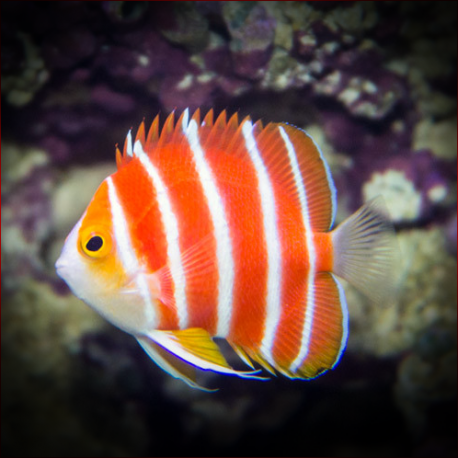More info
Datasheet
| Minimum Tank Size | Unknown |
| Maximum Size | 7.0cm / 2.76inches |
| Reef Compatible | Unknown |
| Temperament | Unknown |
| Temperature | 22.2°C / 71.96°F - 25.6°C / 78.08°F |
| Specific Gravity | 1.020-1.025 |
| Carbonate Hardness | 8-12 |
| pH | 8.1-8.4 |
General Description:The Peppermint angelfish, scientifically known as Centropyge boylei, belongs to the Pomacanthidae family. These Dwarf Angelfish are renowned for their vibrant colors and are relatively small in size, typically reaching about 10 cm, with some specimens growing up to 18 cm. They are not commonly considered reef-safe due to their tendency to consume coral-produced mucus, potentially harming certain corals like LPS, Zoanthus, and clams.
Aquarium Suitability:Aquarists often find Peppermint angelfish attractive for their manageable size and striking appearance. However, integrating them into a reef tank can be challenging due to their potential coral-nibbling behavior. Careful selection of coral species and ample hiding spots are necessary to reduce the risk of damage.
Care and Hardiness:The hardiness level of the Peppermint angelfish is currently unknown, requiring further research. They typically feed on microalgae and detritus, with some species supplementing their diet with green hair algae. Providing a varied diet with food like Spirulina, nori, and fresh vegetables is essential for their health.
Reef Suitability:The reef compatibility of the Peppermint angelfish remains unknown. While some individuals may coexist with certain corals, there is always a risk of them disturbing or consuming corals in a reef aquarium.
Aquarium Setup:To successfully keep Peppermint angelfish, aquarists should create an environment with plenty of live rocks for hiding places and grazing opportunities. It is recommended to maintain a well-established aquarium with adequate algae growth for the angelfish to "graze" on. Supplementing their diet with algae-rich foods like Spirulina is crucial if natural algae levels are insufficient.
Behaviour:The temperament and behavior characteristics of the Peppermint angelfish are unspecified, warranting further observation and study to understand their social dynamics and interactions within an aquarium setting.
Feeding and Diet:These angelfish primarily feed on small crustaceans like krill, mysis, and artemia, along with zooplankton such as Cyclops and pods. Providing a diverse diet is crucial for their overall health and well-being in captivity.
Habitat and Distribution:The Peppermint angelfish, specifically Centropyge boylei, is native to the Eastern Central Pacific region, specifically found in Rarotonga, Cook Islands. Their natural habitat and distribution play a vital role in understanding their environmental requirements for captive care.

